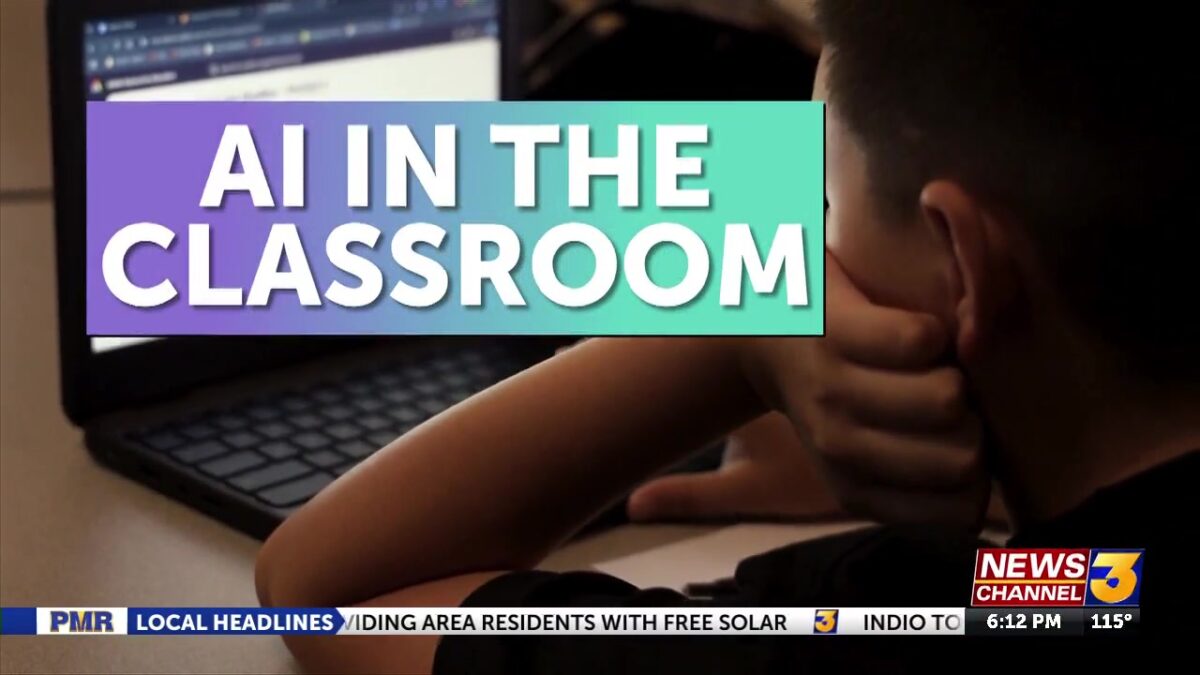In-Depth: How AI is changing curriculum as teachers use it to personalize learning, combat cheating

Angela Chen
It is the dawn of artificial intelligence. And already — kids are using it in their daily lives.
But educational policies and standards at large have not caught up to the dramatic rise of AI and how students are using it, whether for good or bad.
“In my math classes, people cheat with AI, and it’s really invasive in classroom,” said Olivia Aparicio, a senior at Rancho Mirage High School and the president of the Associated Student Body.
She says the use of AI has become ubiquitous, a tool some students frequently abuse.
“Students are so deep into AI use that they understand how to use it now and how to use it to their advantage,” said Aparicio. “They can get away with almost anything.”
ChatGPT, Google Gemini, Claude, Synthesia, Snapchat AI and so many more AI platforms offer a horizon of seemingly infinite possibilities.
We are in the Wild West when it comes to AI, with educators still trying to figure out the best way to incorporate — and police it — in the classroom.
Instructors are seeing heavier workloads and spending substantially more time now monitoring for cheating, according to a recent report, “Time for Class: Bridging Student and Faculty Perspectives on Digital Learning 202,” by education consulting firm Tyton Partners.
AI has the capability to solve math problems while showing the work or construct entire essays while personalizing it to grade level ability. It can even incorporate grammar mistakes to mimic human error.
Teachers say students started doing this years ago when ChatGPT debuted in 2022.
Increased reliance on AI has been linked to an erosion in critical thinking skills, according to a study by Michael Gerlich at the Center for Strategic Corporate Foresight and Sustainability at SBS Swiss Business School.
It’s something educators are trying to balance as they navigate the AI frontier.
At James Workman Middle school in Cathedral City, generative AI is already part of the curriculum.
“We really have to teach kids the possibilities inherent in AI as a thought partner, rather than as something to offload the work to,”said Jessica Pack, a 6th grade teacher at James Workman. “And I think that students themselves have a desire and motivation to be good at something.”
In Jessica Pack’s 6th grade classroom, AI is used to motivate. On the day News Channel 3 came to interview Pack, kids were visualizing their future — literally, through the use of generative AI. Students wrote out what they wanted to be 15 years from now and then, used generative AI to create a photo of that future. Pack is one of the nation’s leading experts on AI in the K-12 classroom and a 2014 California Teacher of the Year. She says teachers have to adapt — or get left behind.
“AI is here to stay, so I think it’s our responsibility as professionals to understand AI: how it works, tools that are most appropriate for the K-12 setting, and what the best practices and ethics are,” said Pack.
It seems it’s certainly here to stay. For students, AI is already ingrained in their lifestyles, as they use it to organize school work, navigate friend drama or to simply figure out what to eat.
“Some of my friends use AI to vent or personal problems,” said Aparicio. “I use it for recipes. Actually, I was home alone one day, and I didn’t know what to make for dinner, so I asked ChatCPT, “Hey, what can I make with these five ingredients? And it gives you a full on recipe.”
“I definitely think that it is a good resource for learning. I think that they should use it for organization, skills programs, if they need any other small adjustments to their own work, but not to fully do their own,” said Sarabjeet Singh, a student at Desert Hot Springs High School.
It’s top of mind for our school districts.For the start of the 2025 school year, DSUSD already has an AI policy in place. PSUSD also has a written policy, slated for board approval on Tuesday, 08/26/2025. CVUSD plans to take an AI policy to its board for approval on 9/11/2025.
These policies emphasize using AI as a teammate, rather than a replacement for critical thinking. DSUSD’s policy also discourages against using AI writing detector sites, considering them unreliable and biased against English language learners. But the CEO of Copyleaks, an AI detection company, says AI can often do what humans can’t.
“We’re an AI company ourselves, and what our AI models are able to do is really to identify all these different factors that AI is is using or writing in a different way, and really identify and distinguish them between how humans are writing,” said Alon yamin, the CEO and co-founder of Copyleaks. “So we can think about average length of a sentence. We can think about how often you use punctuation. We can think about different phrases that you’re using, and we found that is using specific phrases in completely different frequency, like versus an average person. So AI just writes in a different way, but it’s something that is visible to other AI models, and less so to humans. You could say that it’s AI fighting AI.”
So what is the best way to approach AI? Is AI better at recognizing its own handiwork — or can we only count on humans to do the job?
This is the start of a new technological era, and while we figure out how to fit AI into our lives, AI is advancing every day at a rapid pace — one that education at large in the U.S. has yet to catch up to.
“We’re in a marathon of the advent of AI,” said Pack. “And if it’s 26 miles long, we’re really still in mile one.”